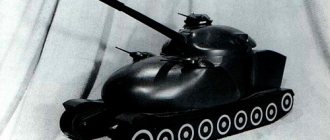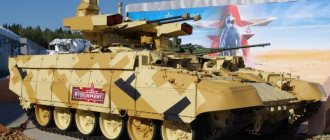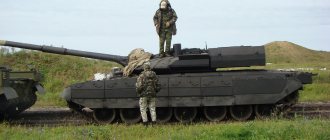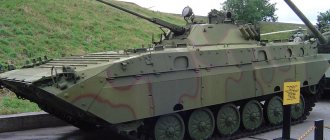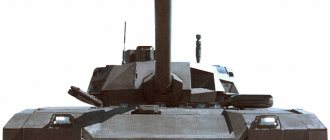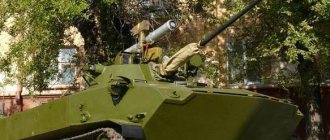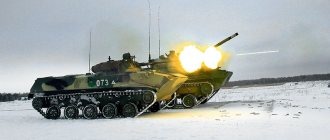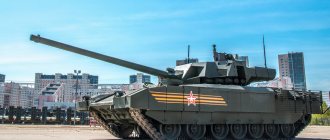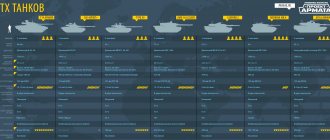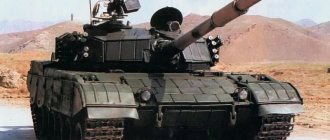The Second World War showed that tanks act as the main strike component in combat strategy. The concept of network-centric warfare, proposed by the Americans, has today become the dominant doctrine of any state that has a more or less capable army. The essence of this concept comes down to increasing the effectiveness of combat formations due to high information content and communication. Also, the combat effectiveness of the army is influenced by the efficiency of making strategic decisions and managing units.
There is another concept aimed at suppressing enemy points by finding his weak points and performing a private combat mission. These two strategies are mutually exclusive. They have common points of contact, and even one can complement the other, but there are also issues that call into question the compatibility of tactics and strategies for using tank formations. If the first concept is implemented taking into account tanks, then the second simply does not provide for them.
A real breakthrough in the field of rearmament was made in Russia with the creation of the T-14 Armata tank. Currently, he is already entering the unit for combat duty. This is a completely Russian development, which perfectly matches the main idea of the doctrine of network-centric warfare.
History of the creation of the tank
A new generation tank in Russia appeared long ago as an order from the Ministry of Defense, but only in the last decade have conversations about a fundamentally new vehicle begun to gain a real foundation. The pre-production package of Armata tanks included 15 vehicles. The real presentation of the new tank took place at the Victory Parade on 05/09/2015, when 10 T-14 units walked along Red Square.
The history of the Armata tank cannot boast of many pages. The developments of the USSR in the field of creating tanks with an uninhabited turret were taken as the basis.
Naturally, the key factor was the competitive rivalry between the Russian Federation and the United States, as well as the implementation of the “Combat Systems of the Future” program. At the research institutes of the Russian Ministry of Defense, the Armata tank began to undergo state tests, which should end in 2022. According to unconfirmed reports, the new tanks were used in real combat conditions in Syria, but the test results have not yet been made public.
The “Combat Systems of the Future” program itself was developed under the heading “Secret”. It is only known that it is under this program that the Russian Federation abandons the production of the T-95 tank, as the main tank of the fourth generation, in favor of the Armata tank. The embodiment of the idea of Soviet developers to create an uninhabited tower (NeoBash) was reflected in a new machine, which at the stage of creation was known under the name “Object-148”. The T-14 index was assigned to the tank already at the final stage of the project.
The Armata tank was chosen as the main one due to its versatility. The vehicle, whose mass reaches 50 tons, is capable of performing combat missions in a group as a “leader”. It can also serve as a fire spotter, target designator and remote reconnaissance device. The tank is equipped with two weapon systems, one of which is a surveillance radar with a hundred-kilometer range, and the other is wide-range equipment.
The reconnaissance complex includes a Pterodactyl UAV connected by wire to the installation. Such a drone can remain in the air for an unlimited amount of time. “Pterodactyl” transmits data in different formats, including in the form of a video image, and the data is transmitted not only directly to the tank, but also to the escort group. The Armata escort group includes:
- T-90 tanks that have undergone modernization;
- Self-propelled gun "Coalition SV";
- T-15 combat vehicle, built on the Armata platform;
- Helicopters;
- Pantsir-S1 complexes;
- Other equipment.
Feedback has also been established, that is, the T-14 tank can receive a video image from the escort group. The Armata combat platform is a universal development of Uralmashzavod, on the basis of which the T-14 tank, T-15 infantry fighting vehicle and T-16 ARV were created.
New steel for armor of the Armata tank
For combined multilayer armor, specialists from the Research Institute of Steel have developed a new armor steel grade 44S-SV-Sh of high resistance electroslag remelting, as well as new materials and filler designs. This made it possible to reduce the total weight of the tank's armor protection by 15% while maintaining armor resistance. Dynamic protection of the T-14 was created according to the principle of design and modification of the configuration to suit the scenario of combat use of the tank. On the march, dynamic protection can be removed, and additional modules can be installed for an urban combat scenario.
Platform, engine, suspension
Fourth generation tanks have special requirements; they precisely determined the concept for the development of the T-14 Armata.
- An uninhabited tower (NeoBash) with automatic loading and reloading of projectiles.
- An armored crew capsule isolated from ammunition, increasing its survivability.
- Transfer of a certain part of the functions under the control of a computer or automated system (partially robotic machine).
The developers left the field to create a fifth-generation tank, that is, a fully robotic vehicle that can be controlled without a crew. As stated above, the Armata platform from Uralvagonzavod is unified for assembling not only the T-14 tank, but also a self-propelled artillery mount.
In the future, it is planned to produce about a dozen types of military equipment, including cars, on this platform. The structure of the Armata tank is implemented according to a modular principle. Thus, entire blocks can be used to retrofit the platform, for example, a communication unit, a control unit, an active protection unit.
The T-14 Armata engine is the same on all platforms of the same name. It has the following tactical and technical characteristics:
- Engine type – X-shaped, twelve-cylinder, turbocharged, diesel;
- Maximum power – variable, from 1200 to 1500 hp;
- Maximum speed – 90 km/h;
- Power reserve – 500 km;
- Installation location on the platform - front, rear, middle.
The active suspension of the Armata, thanks to the automatic suspension system, allows the tank to overcome off-road conditions without reducing speed. The swing amplitude is reduced by half. This played a positive role in increasing the accuracy of the shot. The optimal speed of a tank for combat is about 30 km/h. The platform is equipped with a semi-automatic gearbox. 8 of the 16 gears are for forward movement, and the rest are for reverse movement.
The key element of the automated “digital board” system is the combat information and control system (CIUS). It is also the “brain” of the entire tank, as it controls all functions until one of the crew members switches to manual control of the equipment. The BIUS can control:
- Active protection system;
- Target search system;
- Active suspension;
- Engine.
The information and control system regularly diagnoses all subordinate systems and informs the crew about detected malfunctions. In some cases, the BIUS gives voice commands to the crew. The developers claim that the only thing that separates Armata from a fifth-generation machine is the lack of artificial intelligence.
Elder brother of "Armata"
In the Object 195, the predecessor of the T-14, the designers of Uralvagonzavod implemented two major innovations: an uninhabited fighting compartment and an armored capsule for the crew. The new, however, turned out to be slightly forgotten by the old - in the fifties, the USSR already tried to separate the weapons and crew into separate modules, however, only in the project. Similar work was carried out in the eighties.
The “one hundred and ninety-fifth” capsule had enhanced armor protection on all sides: on the sides, roof, and forehead. An armored partition also separated the tankers from the fighting compartment. In addition, the design of the fighting compartment was made in such a way that the shock wave during an explosion would go anywhere, but not towards people. This, of course, did not guarantee one hundred percent survival, but the crew’s chances of surviving became many times greater.
The uninhabited fighting compartment of the new tank is fully automated. Inside there was ammunition and loading mechanisms. The tower served as a gun carriage. At the same time, it served as additional protection against roof-piercing ammunition - obviously, it is much more difficult to penetrate such an obstacle than a single sheet of armor. Tank crews were supposed to enter the fighting compartment only in case of a crisis situation, for example, when mechanisms failed.
The main armament of the “one hundred and ninety-fifth” was the smooth-bore 152-mm 2A83 cannon, which provided enormous capabilities for hitting targets with both finned sub-caliber shells and new types of guided missiles.
“Object 195” passed state tests in the late 2000s, but did not go into production. There were several reasons. Firstly, the 152-mm cannon turned out to be excessively powerful; at that time there were no opponents for its projectile and there were no opponents in the near future. Secondly, the “one hundred and ninety-five” had small ammunition - only 24 rounds. In order to fight only enemy equipment, this is acceptable. But a modern main tank must cope with a wider range of tasks, and it may happen that loading ammunition too frequently will be difficult or impossible. There were also complaints about the armor of the Object 195: while its forehead was protected very well, the roof and sides did not meet the new, increased requirements. The industry was also not ready to release the new tank.
Soon after the completion of work on the “one hundred and ninety-fifth”, the “Object 148”, also known as the T-14, appeared. This particular tank is now called “Armata”. The T-14 absorbed all the best that was on the Object 195, but at a qualitatively new technological level.
Armor and protection
Armor in a tank plays a vital role. Its task is not only to preserve the lives of the crew, but also to preserve the tank as a whole, since the cost of production and operation of the vehicle is very high.
The approximate price of one T-14 Armata tank is 500,000,000 rubles.
A representative of Uralvagonzavod reports that for testing, 100 vehicles were assembled under the contract with a total cost of 25 billion rubles. The plant's capacity is enough to assemble five hundred units of equipment in one year. It is expected that as Armata tanks become available to the Russian troops, their price will decrease. However, even now the T-14 tank is considered the cheapest tank among its NATO counterparts. The developers cannot be considered mercantile, but it is the cost of the equipment that dictates its requirements for the protection and life support system.
The Armata protection system is represented by a whole complex. First of all, the tank is difficult to get into. But even a hit will not disable it if the ammunition does not penetrate the protective layers. Damages such as failure of the power plant, destruction of tracks or drive failures are relatively easy to repair or the corresponding units are replaced with new ones. The most destructive thing for a tank is the explosion of ammunition. To prevent it, various screens are provided that can remove the energy of the explosion from the capsule with the crew and ammunition in a short time.
Active protection "Afghanit"
The active protection of the Armata tank operates according to a specific algorithm. Throughout the entire survey, radars, cameras and direction finders are constantly operating at 3600. They scan space with a wide spectrum of radiation, including infrared and ultraviolet radiation. After detecting an enemy weapon, the tower automatically rotates in its direction. Such an action entails several consequences:
- Several blinding means are activated to change the trajectory of guided projectiles. Disorienting curtains are installed, heat traps are fired, and means that remove electronics and laser guidance of enemy weapons are activated.
- The impact cores of the missiles are intercepted and destroyed by automated mortars installed under the turret, or machine guns on the turret itself. Fragmentation damage destroys missiles within a radius of 20 meters around the tank, but counterattack ammunition does not protect the tank from attack from above.
- If the projectile is not destroyed by the active protection of the Afghanit, then contact with the armor will occur in the frontal part of the tank, that is, where the hull has the most effective protection.
- It is possible to strike back at the enemy.
Active protection infrared cameras:
- They work in the event of the main radar being turned off, as well as in situations where the enemy uses electronic countermeasures;
- Monitor radar readings and prevent false alarms;
- The presence of radiation is recognized if a laser beam falls on the T-14 tank.
Dynamic protection "Malachite"
The Malachite dynamic protection complex is considered the second level of protection for the Armata tank. It consists of blocks with containers of a cellular structure. The cells have different sizes and are refilled with a special composition after use. The latest version of dynamic protection can operate in automatic mode and operate in conjunction with the active protection of the tank.
The operating principle of the Malachite protection and its effectiveness have not been fully disclosed. It is only known that it is capable of practically grinding enemy shells, protects the tank from light RPG missiles, heavy ATGM missiles and from armor-piercing sub-caliber shells. Special sensors detect the magnetic field of a flying projectile, inducing an electric current. The cell cap, which has damaging properties, is thrown towards the enemy weapon. If the projectile passes further, it hits the dynamic cell and stops.
The Malachite dynamic protection complex can be additionally equipped with blocks in the front of the tank. They cover NeoBash on the sides and top. Thus, with a length of 10.5 meters and a width of about 4 meters, the tank is covered with protection on top by 2/3. The Malachite system has undergone changes. In Armata tanks it is represented by cells located in blocks in several layers. It is expected that such protection will be fully countered by NATO and American heavy missiles, as well as finned sub-caliber projectiles.
The Malachite complex neutralizes enemy missiles mainly with various types of screens and anti-electronic means. Only within a radius of 20 meters from the tank are missiles destroyed by grenade fragments. Thus, the protection system is safe for infantry, provided that, according to the Charter, it moves behind the T-14 tank.
Hull armor
The third line of defense of the Armata tank is its armor. Compared to the armor of third-generation tanks, the Armata’s protection had improved qualities by 10-15%. In some places inside the hull, special armored partitions are installed to enhance overall protection. The coating is designed in such a way that guided and unguided missiles are guided away from the central impact into the plane of the armor.
The damping of the kinetic energy of the projectile, as well as the displacement of the axis of its impulse, occurs due to ceramic inserts in the armor. If we do not take into account the subtleties of expert assessments of the effectiveness of protection, since most of the methods still remain classified, then we can only say that in armor equivalent the Armata’s protection is 1 meter of homogeneous metal armor. The penetration of modern shells does not exceed 700 mm.
The vehicle's crew, consisting of 3 people, is located in the front part of the tank hull. They are located in a special compartment - an armored capsule, which provides reliable protection against damaging elements. The armored capsule is designed not only to be hit by a live projectile, but also isolates the crew in the event of an ammunition explosion. The developers claim that the compartment with the crew can even withstand the damaging factors of a nuclear explosion, unless, of course, the tank is located at its epicenter. It is not yet possible to actually verify these statements.
The armored capsule is equipped quite modernly; certain developments concern the comfort of the crew. So, in addition to semi-automated electronic and mechanical equipment, the capsule has air conditioning, all-round monitors, and comfortable chairs. The image displayed on the screens has high resolution. The crew feels no more cramped than in a car.
Above the tracks there are armored screens that protect dynamic protection elements. The stern and turret of the tank are covered with lattice screens. At the Victory Parade, these screens are dismantled in order to improve the aesthetic appearance. The total mass of additional protection barely exceeds a thousand kilograms, that is, it is only 2% of the tank’s mass, so Armata has high maneuverability. The vehicle is given even greater invulnerability by dynamic “armor” blocks in soft packaging, which are hung around the perimeter of the turret when fighting in urban environments.
The Armata tank is also protected from below by armor. The bottom is V-shaped to dissipate the impulse of anti-tank mines. The tank “can” neutralize mines with a magnetic fuse remotely due to distortion of the magnetic field. Despite the fact that the bottom of the tank is reliably protected, the seats of the crew members are equipped with additional elements that absorb and divert explosion energy.
Fuel tank protection
In the T-14 tank, the fuel tanks are made in the form of permanent structures. They are located in the center of the body, directly in front of the engine, and also on the sides of the car. The tanks have a special fireproof filler that protects the tank from fire. Additionally, the tanks are protected by an anti-cumulative screen. The fuel compartments are separated from the remaining compartments by an additional armored partition. The capsule with the crew is isolated by its own walls.
Inside, the space of the tank is divided into four parts. These include the fuel compartment, the engine compartment, the crew capsule and the ammunition compartment that runs around the sides of the armored capsule. This arrangement reduces the risk of crew death from the explosion of 45 rounds of ammunition. The total capacity of the fuel tanks reaches two tons. About half of this fuel fills the fenders on the sides of the tank. All compartments are equipped with automatic fire extinguishers that are activated when an open fire occurs.
Stealth developments
Stealth technologies have long been used in the creation of military equipment. Their main purpose is to make the vehicle as invisible as possible to the enemy. Similar technologies were used in the design of the Armata tank. Russian weapons are famous not only for their firepower, but also for their invulnerability to the enemy, and the stealth technologies used in the T-14 tanks are implemented through the following developments:
- The reflective edges of the tank's hull make it "invisible" to radar in any applicable range. This special coating prevents the case from heating up from sunlight.
- The tank's thermal traps distort the picture when irradiated by radars operating in the infrared wavelength range. The thermal insulation of the housing also plays a significant role.
- The casing placed on the tower serves as an additional obstacle to radars.
- There is protection against magnetometric weapons. It distorts the magnetic field around the car.
- A system that mixes exhaust gases with the surrounding air, as well as false exhaust pipes, disorient the enemy observing the tank using a thermal range device.
Victor Fomin
— And once again about the Internet. About a month ago I came across the arguments of one blogger with a not very euphonious nickname on the topic of the T-14. This is what he stated: “Armata” was developed on the basis of the obviously flawed so-called technology, not used anywhere in the commercial industry. modular universal platform... Meanwhile, in the global industry, no one is developing idiotic “platforms” - ALL OVER THE WORLD THEY ARE DEVELOPING UNITS FROM WHICH YOU CAN ASSEMBLE ANY PLATFORMS!” This is what happens when a cake maker gets ready to sew boots. If he had been aware, he probably would not have stooped to such nonsense. Because the WHOLE WORLD, represented by the automobile industry, is already moving towards a similar design system. Examples? Please: MQB (VW), EMP2 (Peugeot), etc.
The armor is strong and the tanks are ours! Premieres of the Victory Parade
Detection complex
The ability to detect the enemy for the Armata tank is one of the main functions. A four-section radar with cameras allows you to detect enemy forces within a radius of 10 km, as well as at boundaries of up to 100 km. The phased array radar provides tracking of 40 ground and 25 air targets. Intervention by crew members in the operation of the tracking system will only be required when the target is thoroughly camouflaged. The tank driver is guided by the indicators of the optical periscopes. Infrared headlight illumination provides a clear picture even at night.
For the first time, the developers used the Pterodactyl unmanned aerial vehicle for short-range reconnaissance. It is capable of flying within a radius of up to 100 meters, as it is connected to the machine by a shielded cable through which a video image is transmitted. The observation horizon of the aircraft is 10 km. This makes it possible to fight from cover or from the suspension of a masking cloud. It is noteworthy that the picture received by Pterodactyl can be transmitted not only to the corresponding tank, but also to all vehicles in the tactical group.
The detection system operates with small errors, but they do not interfere with targeted fire. For example, the error in the position of a target located at a distance of 10 km does not exceed 17 meters. The tank can fix the location of the explosion, and therefore serves as a fire spotter. The system tracks the launch site of enemy ammunition and transmits data to the accompanying T-15 infantry fighting vehicle, a unit with MANPADS or the Pantsir-S1 air defense system.
